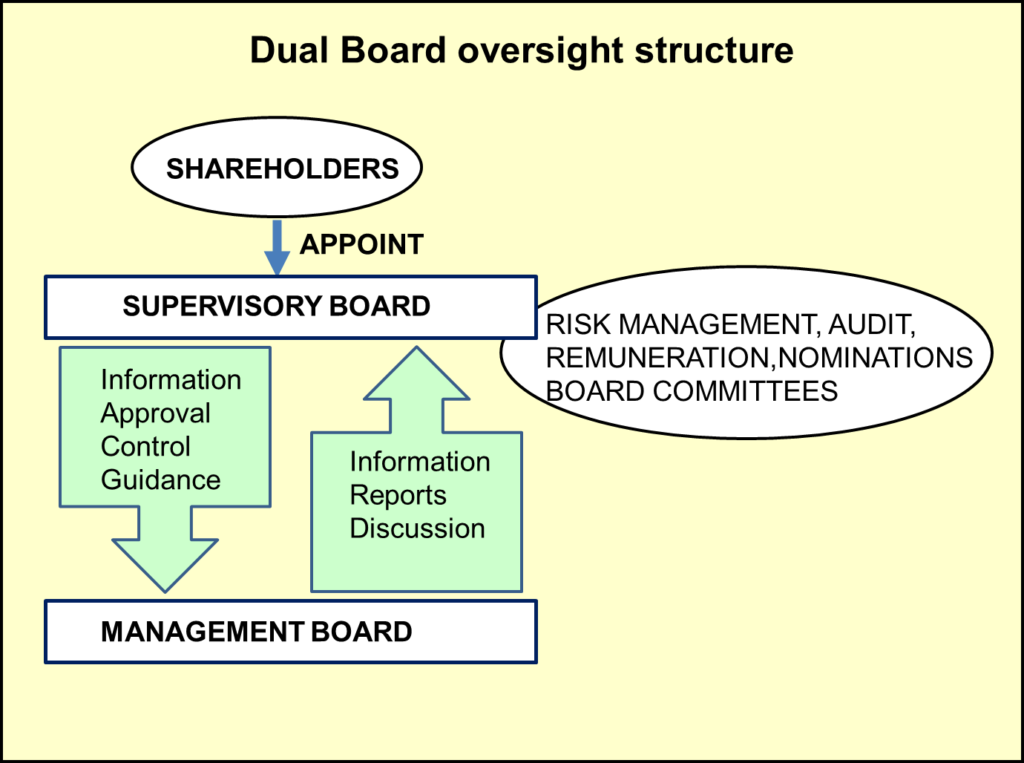Approaches to Corporate Governance & Useful Links
At shareholder level, Corporate Governance deals with the arrangements under which oversight is exercised on the management and affairs of the company on behalf of its owners. There are two principal approaches that inform these arrangements :
- the two-tier oversight approach, which is historically associated with Germany and adopted in a number of countries in Europe (Austria, Finland, Sweden) and China
- the unitary oversight body approach, which is associated with the UK and USA and adopted in many other countries.
In many countries, Corporate Governance Codes are often used to guide companies on what constitutes appropriate governance arrangements. You can download the relevant Corporate Governance Code for specific countries from the European Corporate Governance Institute (ECGI) www.ecgi.com, an international scientific non-profit association providing, a forum for debate and dialogue between academics, legislators and practitioners, focusing on major corporate governance issues. www.ecgi.global/content/codes
The two-tier board oversight structure
Under this approach, there are two separate boards, an Executive or Management Board for day-to-day business and a Supervisory Board elected by shareholders and in some countries also employees, for appointing and supervising the Executive or Management Board. Oversight is exercised by two separate Boards of Directors.
The Supervisory Board is chaired by the Chairman of the Company and is usually made up of non-executives, though in some jurisdictions it can include employee representatives. Generally, the Supervisory Board guides and monitors the Management Board. The Supervisory Board is also involved in long term strategic planning.
The Management Board is made up exclusively of executives and is led by the Chief Executive Office (“CEO”) of the company. It meets frequently, often weekly, to deal with operational issues. Some contracting decisions and strategic planning decisions may have to be approved by the Supervisory Board.
The two board have to co-operate closely in developing the business strategy through a steady flow of information between the two boards. The information flow normally includes risk management, business development and any deviations from initially agreed plans. Open discussions between members of the boards are also vital for the functionality of the business under the Dual Board management system as the boards must exchange information frequently.

What is Codetermination ?
The dual board system is closely associated with Germany as it was introduced in the country in the 19th century. Since 1976, under German law, workers have the right to participate in the management of the companies they work for via electing representatives (usually trade union representatives) to the Supervisory Board of Directors. In companies with more than 2,000 employees, such employee representatives may make almost half the Supervisory Board and in companies with less than 2,000 employees but more than 500 employees, employee representatives make up a third of the Supervisory Board. This employee participation is called “Codetermination” and clearly contributes to better information sharing and to building trust between employees and their companies/managers which can lead to relatively peaceful industrial relations. On the other hand, decision making can be slower though some studies, notably in Sweden, have suggested efficiency improved with worker representation.

The dual board system has been adopted by other countries, mainly European and Asian, including Austria, Netherlands, Finland, Sweden, China.
The unitary board oversight structure
Under this approach, there is only one oversight body, the Board of Directors, which comprises of both executives of the company and non-executives. In the UK, since the early1990s following the recommendations of the Cadbury Report (1992), the role of Chairman and Chief Executive Officer are held by two different people. In the USA, the role of Chairman and Chief Executive Officer can be combined and very often one person holds both posts, but there is a trend towards splitting the role. So, there are in effect two variants of the unitary Board structure – the UK variant and the US variant.
Comparison between unitary and dual board structures
There are arguments in favour of each of the approaches and variants. Proponents and adherents of the Dual Board approach point to the clear distinction it ensures between management by the executive board and governance by the supervisory board which in their view allows clearer lines of authority. The aim is to prevent a conflict of interest and too much power being concentrated in the hands of one person. Some acknowledge a strong parallel of the Dual Board approach with the structure of government, which tends to separate the political cabinet, ultimately accountable to voters who elect the parties that form such a cabinet, from the management civil service that acts according to the directions of the cabinet. Using a two tier system might also result in “more monitoring” and “less aggressive performance targets”, particularly where employees are strongly represented in the Supervisory Board. Critics of the Dual Board approach suggest that financial efficiency may be impeded by reduced communication and the higher costs of running two boards.
Proponents and adherents of the Unitary Board approach point to lower oversight costs of having just one board mixing executives and non-executives and also to speedier decision-making and greater flexibility in changing strategic direction, particularly in the absence of worker representatives at the Board level. Proponents of the US approach of combining the roles of Chairman and CEO, point to the powerful platform that this creates for exceptional leaders to make a big difference to the fortunes of the companies they lead. On the other hand, proponents of the UK approach of splitting the Chairman and CEO roles, point to lower concentration of power in the hands of one individual and greater checks and balances that result in greater resilience.
There is no settled opinion on what structure is “best” as there are examples of excellent outcomes as well as poor outcomes under both unitary boards and two tier boards. Fundamentally, such structures are simply tools in the hands of executive and non-executive directors. Utlimately it is the directors’ responsibility to achieve Good Corporate Governance whichever way they see fit given the environment in which their companies operate.

